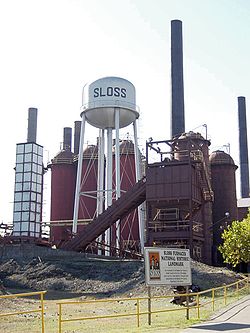nBirmingham.net
Sloss Furnace in Birmingham Alabama
Sloss Furnaces is a National Historic Landmark in Birmingham, Alabama in the
United States. It was operated as a pig iron-producing blast furnace from 1882
to 1971. After closing it became one of the first industrial sites (and the only
blast furnace) in the U.S. to be preserved for public use. In 1981 the furnaces
were designated a National Historic Landmark by the United States Department of
the Interior.
The site currently serves as an interpretive museum of industry and hosts a
nationally-recognized metal arts program. It also serves as a concert and
festival venue. Current plans call for a $10 million program of accelerated
restoration and construction of a new, larger visitor's center. The furnace
site, along a wide strip of land reserved in Birmingham's original city plan for
railroads and industry, is also part of a proposed linear park through downtown
Birmingham. An annual Halloween haunted attraction called "Sloss Fright Furnace"
is held at the site.
History
In 1886 Sloss retired and sold the company to a group of investors who reorganized it in 1899 as the Sloss-Sheffield Steel and Iron Company. New blowers were installed in 1902, new boilers in
 |
1906 and 1914 and the furnaces
completely rebuilt with modern equipment between 1927 and 1931. Through this
aggressive campaign of modernization and expansion, including furnace and mining
and quarrying operations all around Jefferson County Sloss-Sheffield became the
second largest seller of pig-iron in the district and among the largest in the
world. During this period the company built 48 small cottages for black workers
near the downtown furnace — a community that became known as "Sloss Quarters" or
just "the quarters".
In 1952, the Sloss Furnaces were acquired by the U.S. Pipe and Foundary Company,
and sold nearly two decades later in 1969 to the Jim Walter Corp. The Birmingham
area had been suffering from a serious air pollution problem during the 1950s
and 1960s, due to the iron and steel industry there, and Federal legislation
such as the U.S. Clean Air Act was causing the closure of older and out-of-date
smelting works. Also, all of the iron ore in the Birmingham area had been used
up, and more expensive foreign and out-of-state ore was feeding the blast
furnaces.
The Jim Walter company closed the furnaces two years later, and then donated the
property to the Alabama State Fair Authority for possible development as a
museum of industry. The authority determined that redevelopment was not feasible
and made plans to demolish the furnaces. Local preservationists formed the Sloss
Furnace Association to lobby for preservation of this site, which is of central
importance to the history of Birmingham. In 1976 the site was documented for the
Historic American Engineering Record and its historic significance was detailed
in a study commissioned by the city. Birmingham voters approved a $3.3 million
bond issue in 1977 to preserve the site. This money went toward stabilization of
the main structures and the construction of a visitor's center and the
establishment of a metal arts program.
Preservation and restoration work continues at Sloss and funds are being raised
for a major expansion of the interpretive facilities in a new visitor's center.
The site is proposed to become part of a linear park running east-west through
downtown Birmingham along the route of the "Railroad Reservation", which was a
strip of land zoned for industrial development in Birmingham's 1871 city plan.
In February 2009 Sloss became the new home of the SLSF 4018 steam locomotive,
which was relocated from Birmingham's Fair Park.
Present use
Sloss is currently used to hold metal arts classes, a barbecue cookoff, Muse of
Fire shows, and concerts. Being a reportedly haunted location, it is also an
annual Halloween haunted attraction.